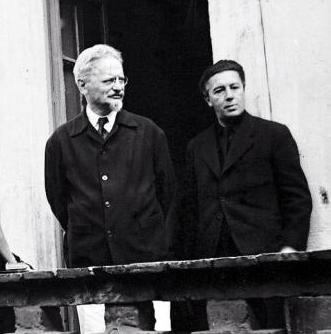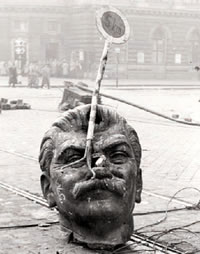A SHORT HISTORY OF THE NEW YORK INTELLECTUALS
THE MOST INTERESTING PLACE IN THE SOVIET UNION
 ew York Intellectual Lionel Abel wrote that New York City in the 1930s was "the most interesting part of the Soviet Union." Radicalism was on the rise and the American Communist Party,. after years spent in obscurity, was drawing many leading intellectuals like Malcolm Cowley and Edmund Wilson into its orbit.
ew York Intellectual Lionel Abel wrote that New York City in the 1930s was "the most interesting part of the Soviet Union." Radicalism was on the rise and the American Communist Party,. after years spent in obscurity, was drawing many leading intellectuals like Malcolm Cowley and Edmund Wilson into its orbit.
As the Great Depression hit in the early part of the decade, everyone seemed to be looking for an answer to the sudden collapse of the economy.. The city blossomed with radical groups. Among their strongest adherents were the East European Jews who had immigrated to America in the years before and after the turn of the century.
Among many of the New York Intellectuals, radicalism had been a family tradition. Irving Howe, Nathan Glazer and Daniel Bell all had parents who belonged to the International Ladies Garment Workers and voted for the Socialist party, while Irving Kristol's father was a member of the Amalgamated Clothing Workers. While still in their teens both Irving Howe and Daniel Bell joined the Young People's Socialist League.
Socialism promised more than a better economic future; it held out the hope that they might move beyond the narrow confines of their immigrant world and the stigma of being Jewish. Alexander Bloom, author of Prodigal Sons, The New York Intellectuals and Their World, writes that, "The cosmopolitan philosophy of the radical causes offered the hope of a world where being Jewish would not make any difference." he writes. At the same time, "Rather than forcing a total break with their parents, [socialism] allowed a degree of continuity with their own past and traditions and served as part of a transition from the ghetto margins to the larger society."
Radical political life was played out in parks like Union Square or on neighborhood street corners where speakers would seduce passersby to gather around them. Nathan Glazer and Irving Kristol both remember stopping to hear these speakers, while Irving Howe and Daniel Bell actually mustered the courage to mount the street speaker's ladder themselves.

PARTISAN REVIEW
 he greatest intellectual influence on the boys of alcove one was a young journal called Partisan Review, dedicated to joining Marxist radicalism with the modernist literary sensibility. PR had originally begun life in 1934 under the auspices of the Communist Party But its two chief editors Phillip Rahv, a Party member and William Phillips, a fellow traveler of the Party, soon found themselves chafing under the Party's dogmatic political and cultural dictates and its strident attack on modernism.
he greatest intellectual influence on the boys of alcove one was a young journal called Partisan Review, dedicated to joining Marxist radicalism with the modernist literary sensibility. PR had originally begun life in 1934 under the auspices of the Communist Party But its two chief editors Phillip Rahv, a Party member and William Phillips, a fellow traveler of the Party, soon found themselves chafing under the Party's dogmatic political and cultural dictates and its strident attack on modernism.By 1937, Rahv and Phillips had broken from the Communist Party and begun to publish Partisan Review as an independent journal. The magazine's early board of editors and writer, all in their twenties and thirties, would become the core of the group that Howe would later christen "The New York Intellectuals." It included literary critics, F.W. Dupee and Lionel Abel; novelists, Mary McCarthy and Saul Bellow; political essayist Dwight McDonald; and Clement Greenberg and Harold Rosenberg, art critics who would, in a few years time, champion Abstract Expressionism.
Partisan Review and its essays ultimately came to define the New York Intellectual style: a self-consciously brilliant intellectual journalism that was unafraid to tackle almost any issue, cultural or political. The articles inPartisan Review were both densely written and wide-ranging in their scope. More than anything, they exhibited a sense of intellectual engagement that would become the hallmark of the group.
As Marxists, the PR writers were committed to changing the world, not merely writing about it. Though this attitude was, in part, a mark of the naivete of a group of young writers bent on political revolution, it left a lasting imprint on the group which led to a life-long political engagement with the central issues of their day.
Intellectual historian Terry Cooney, author of The Rise of the New York Intellectuals, Partisan Review and its circle 1934-1945, explains that, "Marxism and modernism came together for the new Partisan Reviewthrough the [Hegelian] ideal of synthesis. If it was to move forward [these individuals felt] literature must preserve the sophistication and boldness of modernist writing; yet it must combine with that the analysis of society inherent in Marxism, the whole package being held together by a positive sense of historical direction and purpose." The two movements were, however, often politically at odds: many of the modernists like Eliot were conservative and some like Ezra Pound were even reactionary. Yet they seemed also to share important concerns. Modernism, like Marxism, was preoccupied with the alienation and the moral squalor of the moment. Modernist literature offered, as did Marxism, strong attacks on industrial society. Modernist authors, like these young immigrant intellectuals, felt themselves to be at odds with middle class society and prevailing social values. World War One had confirmed for the modernists the moral and social breakdown of the West
The two movements' emphasis on an international vision appealed to these children of immigrants attempting to transcend the parochialism of their own lives. The Partisan Review writers and their City College acolytes fused these two tremendous energies into a radical critique of an American capitalist society in crisis, hoping to provide a path out of the darkness of the Depression.
Ultimately the two movements were, in many ways, politically at odds; many key modernists like T.S. Eliot were politically conservative and others were simply apolitical. Though Eliot chose to attack what he perceived as the West's crisis of values through a radically experimental technique, he meant to recapture a lost past, not usher in a never-before-seen future. Beyond this lay another issue that would only begin to haunt the New Yorkers in later years. The subversive nature of modernism – its critique of middle class values – initially so appealing to them when they felt no economic or social stake in their society grew problematic as they matured and came to appreciate American society.


No comments:
Post a Comment